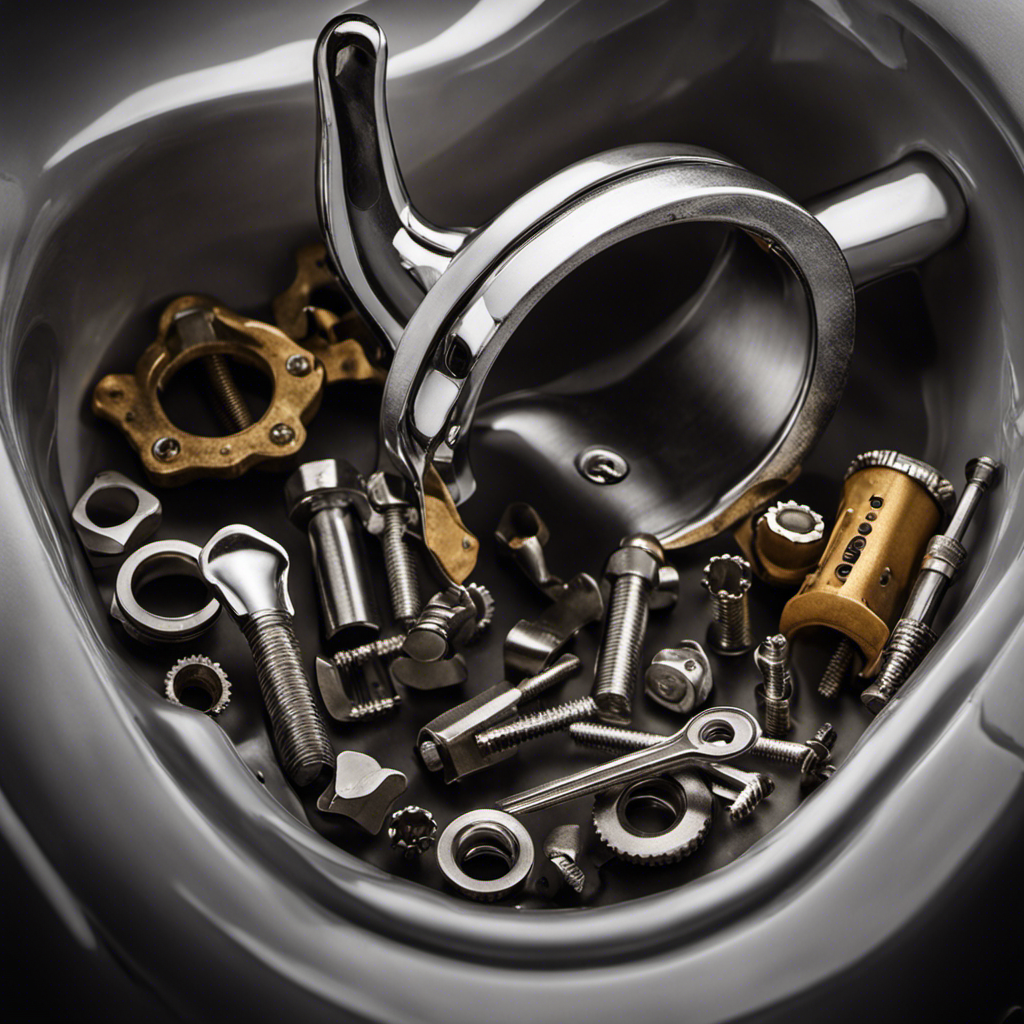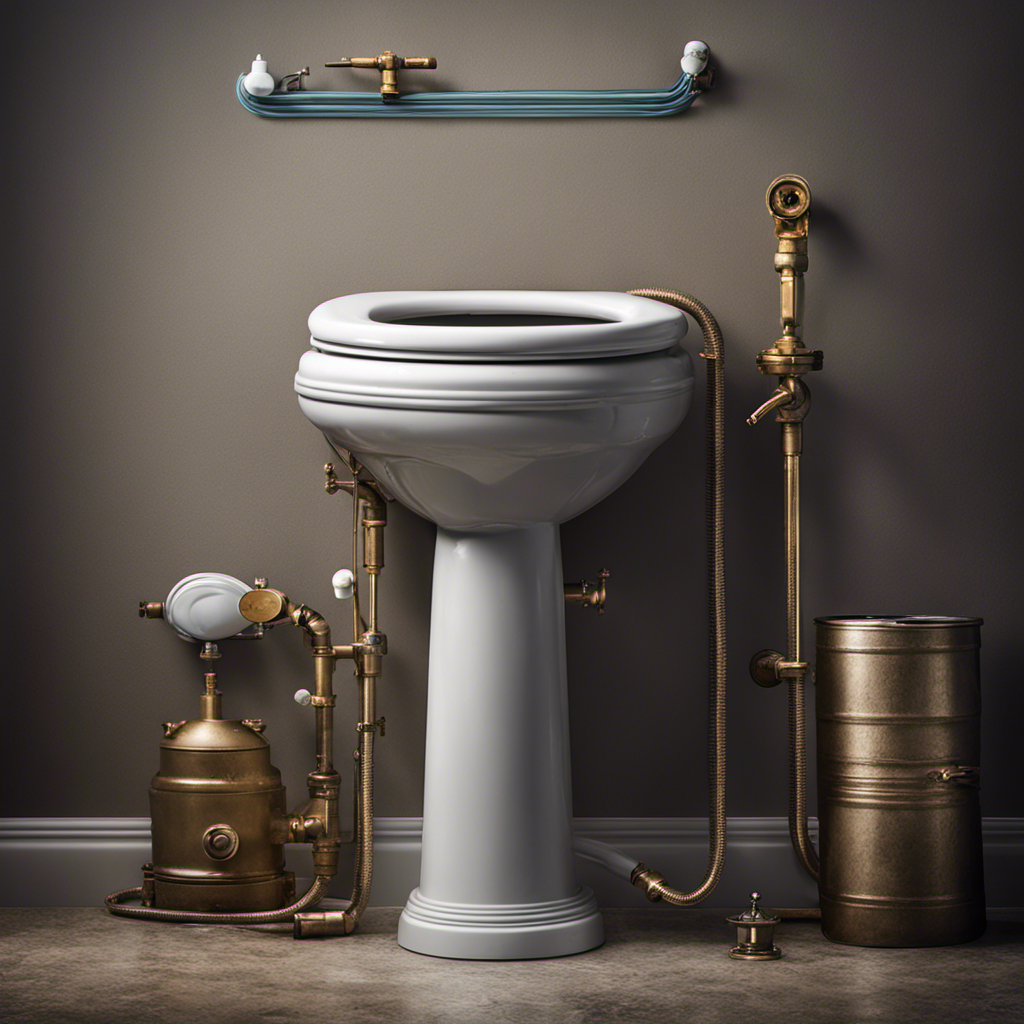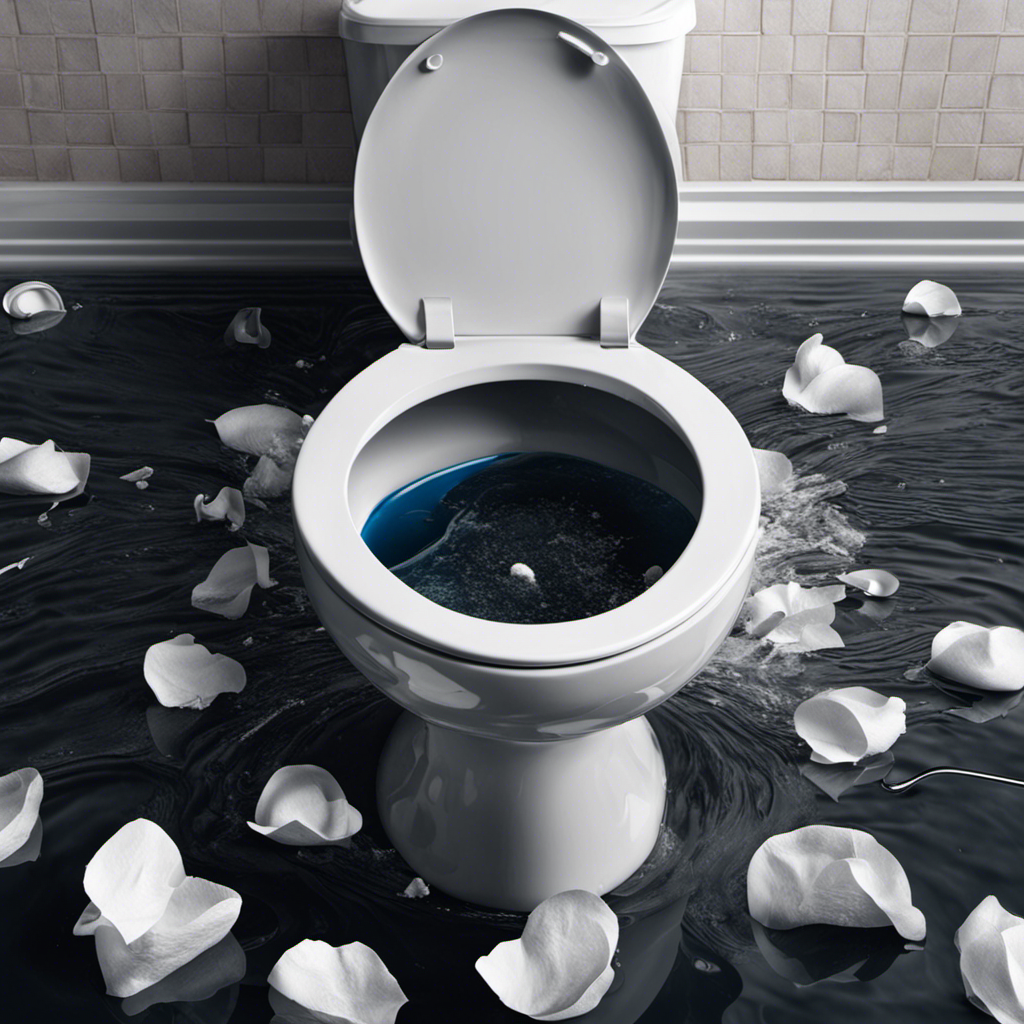I’ve been there – standing in the bathroom, staring at a broken toilet handle, feeling the frustration rise. But fear not, for I am here to guide you through the troubleshooting and fixing process.
In this article, we’ll delve into the intricacies of the toilet system, identify common issues, and provide step-by-step solutions. From tightening a loose handle to replacing a broken one, we’ll cover it all.
So, let’s roll up our sleeves and get that toilet handle back in working order.
Key Takeaways
- Understanding the toilet system helps identify and solve problems with the handle.
- Temporary solution: Manual flushing using a bucket of water.
- Fixing a loose handle by tightening the nut connected to the handle.
- Steps to replace a broken toilet handle: drain tank, remove old handle, insert new handle, attach chain to flapper.
Understanding the Toilet System
Understanding how the toilet system works helps me identify and solve problems with my broken toilet handle.
The toilet system is a complex assembly of parts that work together to ensure a smooth flush. The handle is connected to a lift arm inside the tank, which raises the flapper to allow water to rush into the bowl for flushing.
By knowing this mechanism, I can troubleshoot common toilet handle problems. I can check if the handle is loose or disconnected from the lift arm, and if it is, I can simply tighten it. It’s important to verify if the handle is the actual problem before jumping to conclusions.
Remember to handle the internal parts of the toilet with dry hands to ensure safety.
Identifying the Problem
I can pinpoint the issue by checking if the handle is loose or disconnected from the lift arm. Common signs of a broken toilet handle include difficulty flushing, a handle that feels loose or wobbly, or a handle that doesn’t return to its original position after flushing.
Troubleshooting tips for a broken toilet handle are as follows:
- First, check if the handle is loose or disconnected from the lift arm.
- If the handle is loose, try tightening it by locating the nut attached to the handle inside the tank and gently tightening it with your hand or a wrench.
- If the handle is still not working properly, it may need to be replaced.
- To replace a broken toilet handle, drain the tank, remove the old handle, and insert the new handle, securing it with the nut.
- Remember to turn off the water supply before starting any repairs to ensure safety.
Temporary Solution – Manual Flushing
To temporarily address the issue, I can manually flush the toilet by pouring a bucket of water into the bowl in one swift motion. This DIY handle repair technique can be used as a temporary solution while waiting to replace the broken toilet handle.
By filling a bucket with about a gallon of water and pouring it into the toilet bowl, you can mimic a regular flush. Repeat if necessary.
It’s important to note that manual flushing is only a temporary fix and not a long-term solution. It is recommended to replace the broken handle as soon as possible to restore the proper functioning of the toilet.
This can be done by draining the toilet tank, removing the old handle, and installing a new one following the proper steps.
Fixing a Loose Handle
Tightening the nut attached to the handle inside the tank is a simple way to secure a loose handle. Here are the proper tools and troubleshooting steps you can follow:
- Start by removing the toilet tank lid and locating the nut attached to the handle.
- Use your hand or a wrench to gently tighten the nut, making sure not to over-tighten.
Verify if the handle is still loose or disconnected from the lift arm before proceeding.
If the handle is still not working properly, it may be time to consider replacing it.
Remember to handle the internal parts of the toilet with dry hands to ensure safety.
Replacing a Broken Toilet Handle
Replacing a broken toilet handle is a straightforward process that requires a few basic steps.
First, turn off the water supply to the toilet and flush to drain the tank.
Then, locate and loosen the nut that holds the handle in place. Remove the old handle, making sure to disconnect the chain attached to the flapper.
Next, insert the new handle into the hole in the toilet tank and secure it with the nut.
Finally, attach the chain to the handle, ensuring it has enough slack to seal the flapper.
This DIY handle repair can be done with common household tools and doesn’t require professional assistance.
Importance of Fixing a Broken Toilet Handle
Fixing a broken toilet handle promptly is essential to prevent further damage and ensure the proper functioning of the toilet. Ignoring a broken handle can lead to more expensive repairs in the future and wasted water, resulting in higher water bills. So, it is important to address this issue as soon as possible.
Here are some alternatives to fixing a broken toilet handle:
-
Temporary solutions: Manual flushing using a bucket of water can serve as a temporary replacement for a broken handle.
-
Fixing a loose handle: Tightening the nut inside the tank that has loosened over time can fix a loose handle.
-
Replacing the handle: If the handle is still not working, it may be time to replace it. Drain the toilet tank, remove the old handle, and install a new one.
-
Seeking professional help: If temporary solutions are not effective or sustainable, it is advisable to seek professional assistance.
-
Upgrading the handle: Consider upgrading to a higher quality handle for better durability and longevity.
Addressing a broken toilet handle promptly can save you from costly repairs and improve the overall functionality of your toilet.
Common Causes of a Broken Toilet Handle
When the toilet handle becomes unresponsive, it can be frustrating and inconvenient.
Common causes of a broken toilet handle include excessive force, corrosion, poor quality materials, and incorrect installation.
To fix a broken handle, there are DIY handle repair techniques available. One option is to tighten a loose handle by locating the nut attached to the handle and gently tightening it with a wrench.
If tightening doesn’t work, replacing the handle is another option. To replace a broken handle, drain the toilet tank, remove the old handle, and insert the new handle, securing it with a nut.
It’s important to fix a broken toilet handle promptly to prevent further damage.
Prevention Tips for a Broken Toilet Handle
To prevent a toilet handle from becoming unresponsive, I should regularly inspect it for signs of wear or damage. Maintaining a toilet handle is crucial for its proper functioning and avoiding costly repairs.
Here are some key tips for toilet handle maintenance:
- Inspect the handle for any cracks, rust, or looseness.
- Lubricate the handle mechanism with silicone or graphite to prevent corrosion.
- Consider upgrading to a higher quality handle for better durability.
- Follow proper installation guidelines to ensure the handle is secure and functional.
- Choose the right toilet handle that suits your needs and the toilet system.
By following these maintenance tips and selecting the right toilet handle, you can ensure a smooth and reliable flushing experience.
Don’t overlook the importance of proper maintenance to avoid inconvenience and costly repairs in the future.
Proper Repair Techniques for a Broken Toilet Handle
Now that we have discussed prevention tips for a broken toilet handle, let’s move on to proper repair techniques. Fixing a broken toilet handle is a relatively simple task that can be done with a few basic repair tools and some troubleshooting steps. Here is a table outlining the necessary tools and the steps to follow for repairing a broken toilet handle:
| Repair Tools | Troubleshooting Steps |
|---|---|
| – Adjustable wrench – Screwdriver – Replacement handle |
1. Turn off the water supply to the toilet. 2. Remove the lid of the toilet tank. 3. Disconnect the broken handle from the flushing mechanism. 4. Install the replacement handle, ensuring proper alignment. 5. Test the new handle by flushing the toilet and check for any issues. |
Seeking Professional Help
I should consider reaching out to a professional for assistance with this issue. When to call a professional:
- Unresolved issue despite attempts at DIY repair.
- Inability to identify the root cause of the problem.
- Lack of knowledge or experience in handling toilet repairs.
- Complex or extensive repairs required.
- Safety concerns or risk of further damage.
Signs that indicate a need for professional help:
- Persistent leaks or recurring problems.
- Unusual noises or vibrations during flushing.
- Inconsistent or weak flush performance.
- Water pooling around the base of the toilet.
- Foul odors or sewage backups.
Calling a professional ensures that the problem is accurately diagnosed and effectively resolved. They have the expertise, tools, and experience to tackle complex repairs. Don’t hesitate to seek professional help when needed to avoid costly mistakes or further damage.
Frequently Asked Questions
Can I Use Any Type of Handle as a Replacement for a Broken Toilet Handle?
Yes, you can use alternative handle options as a replacement for a broken toilet handle. However, it is essential to ensure that the handle materials are compatible with the toilet system to ensure proper functionality and durability.
How Do I Know if the Chain Attached to the Flapper Is the Correct Length?
To adjust the chain length for a toilet flapper, first, turn off the water supply and remove the toilet tank lid. If the chain is too long or too short, adjust it accordingly for proper functioning.
Is It Necessary to Drain the Toilet Tank Before Replacing a Broken Handle?
No, it is not necessary to drain the toilet tank before replacing a broken handle. However, it is important to turn off the water supply and flush the toilet to prevent water damage. Hiring a professional is optional, depending on your level of comfort with DIY repairs.
What Should I Do if Tightening the Nut on a Loose Handle Doesn’t Fix the Problem?
If tightening the nut on a loose handle doesn’t fix the problem, I would suggest trying alternative solutions such as using pliers or a wrench to manually operate the flushing mechanism. If all else fails, it may be necessary to seek professional assistance.
Are There Any Signs or Symptoms That Indicate a Broken Toilet Handle Needs Immediate Attention?
If signs of a broken toilet handle, like difficulty flushing or a loose handle, are left unaddressed for too long, it can lead to more extensive damage and costly repairs. Immediate attention is necessary to prevent further issues.
Conclusion
In conclusion, troubleshooting and fixing a broken toilet handle is a task that requires attention to detail and proper knowledge of the toilet system. By understanding the mechanics and identifying the problem, one can take the necessary steps to resolve the issue.
Whether it’s tightening a loose handle or replacing a broken one, it’s important to follow proper repair techniques and consider preventative measures to avoid future breakage.
Remember, a broken toilet handle is like a leaky faucet, dripping away convenience and causing frustration. So, take charge and fix it like a skilled plumber, restoring functionality and peace of mind.










